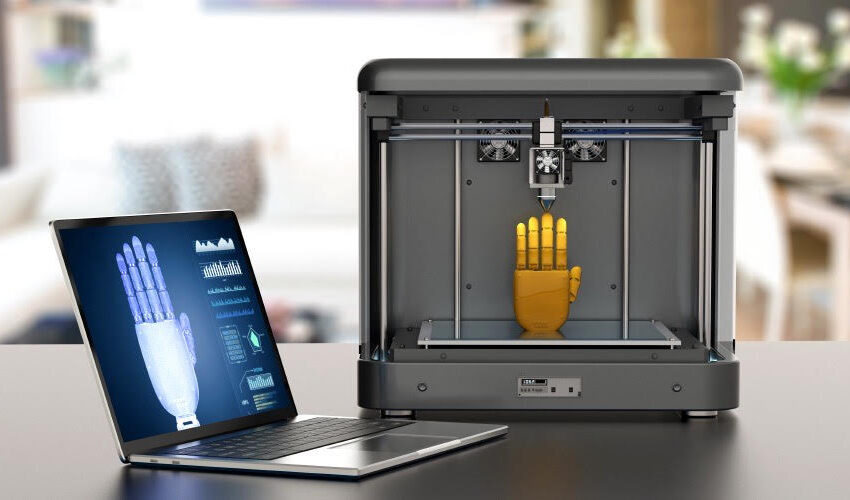3D Printing for the Disability Community
With 3D printing continuing to advance, we decided to take a closer look at how this technology is supporting the disability community through accessibility efforts. 3D printing is both a medical development, similar to medical robots as we’ve previously discussed, and a (potential) cultural marker. Just as many businesses, clinics, and households had desktop computers and standard printers at the turn of the century, it’s looking like 3D printers may be the next “in-house” tech gadget due to its increasing affordability and scalability. The inexpensiveness of 3D printers is precisely the reason for its positive impact on the disability community, among others.
3D Printing and the IoT
The IoT and 3D printing are becoming the standards for technological advancements, and together, they are making it possible to create accessible smart devices that support individuals with disabilities. For instance, CEO of Phoenix Instinct, Andrew Slorance, asserted that wheelchairs have not been improved mechanically over the decades. As a wheelchair user himself, he decided to envision a smart wheelchair powered by the IoT and prototyped using 3D printing. Successfully, the Phoenix i Wheelchair was created. This wheelchair has smart technology which continuously redistributes the user’s weight on the wheelchair based on the user’s movements so that the individual can safely and comfortably use their wheelchair on various terrains.
Similarly, designer Troy Baverstock of Baverstock Designs created a 3D printable smart prosthetic device, limbU, for those who use prosthetic limbs. This bluetooth-connected wearable device serves multiple functions including using its smart sensors to track the limb’s orientation and movement, providing data directly to users’ physicians for proper fitting, and functioning as a phone charger, to name a few. With the help of 3D printing, customized shape, size, and appearance of the prosthetic extension becomes accessible and affordable to the client.
The future of the IoT and 3D printing is vast. From companies and individual designers alike creating assistive technologies using 3D printing and connecting to the IoT, to researchers creating accessible, self-sufficient 3D printed smart devices for individuals with disabilities and/or their caregivers to independently print right from the comfort of their home, these technological advancements are supporting the disability community.
3D Printing and AI
Along with the IoT, 3D printing and Artificial Intelligence (AI) are also beginning to work together to optimize products being printed, in this case, devices that assist folks with disabilities. Specifically, 3D printing is starting to leverage Machine Learning (ML) in order to ensure that whatever is being printed is defect-less. Printpal, a ML firm, created PrintWatch, an AI software that can detect when a defect is occurring during a print job. In addition, PrintWatch will have the 3D printer stop the print job and alert the user when the printed product is forming a defect. When we consider printing prosthetic devices for folks with disabilities, for example, it is incredibly important for safety and cost effectiveness to stop a defect in its tracks before the entire device is fully printed out and unusable for the individual.
Additionally, a Japanese start-up, Instalimb, prides itself for creating an automated 3D printing process using AI technology in order to mass print prosthetic limbs for those in need, including people from other countries. Instalimb recognizes that prosthetists aren’t always available in certain parts of developing countries; using AI, their company can use data taken from previous prosthetic fittings to mass produce and automate adjusted and well-fitted prosthetic limbs.
3D Printing and open-source communities
What makes 3D printing so unique as a technological feat is its ability to make the client the creator of their own product. Not only can companies and medical facilities operate 3D printers to print out various tools that support folks with disabilities, people with disabilities and/or their caregivers can print those products from their very own home. To take it one step further, blueprints and assembly kits, for instance, can and are being offered completely free to those in need, thanks to open-source communities. We know that the concept of open-source is incredibly popular for the future of Web3, and it is no surprise that current online platforms from many technological industries are moving into an open-source model, 3D printing included. The opportunities to scan, create, and assemble an assistive device from one’s own home is becoming especially realistic with the power of open-source communities in the 3D printing sector. Below are three open-source 3D printing platforms that provide free, or majority free, 3D printing services that support the disability community.
- e-NABLE community
e-NABLE is a grassroots, open source community of individuals who use their 3D printers to create free 3D printed fingers, hands and arms for those in need, particularly children with disabilities.
- Thingiverse
Thingiverse is an open source website that allows creators to upload 3D printing files for others to download for free. Specifically, there is a tag on Thingiverse, “disability,” where a variety of assistive equipment is ready to be 3D printed right from someone’s home. Assistive bottle openers, bag carriers, and wheelchair ramps can be downloaded with one click and printed at home.
- Original Prusa i3 MK3S+
This 3D printer, created by Prusa Research, is completely open-source. The Original Prusa i3 MK3S+ has its blueprints and source codes completely published for public use. With this printer, people with disabilities and/or their caregivers are able to easily print any form of assistive device that would be supportive to the individual.
Companies using 3D Printing to support accessibility
Furthermore, there are also companies who are using their businesses to support the independence and wellness of individuals with disabilities via 3D printing services. Below are three examples of companies doing this.
- B9Creations’ x Black Hills Works
B9Creations, a 3D printing manufacturer, partnered with Black Hills Works, a non-profit organization that supports the holistic well-being of adults with disabilities, in order to provide 3D printed custom assistive devices for those in need. There are many barriers to assistive technology, cost, production delays, and (lack of) personalization being the top obstacles; B9Creations asserts that their 3D printing technology will eliminate these barriers. Their B9 Core Med 500 printer provides assistive technology for over 600 adults with disabilities.
- A3D
A3D, also known as Access 3D Services, is both its own firm and a sub-entity of the non-profit organization, Access Independence, an organization that supports independent living for folks with disabilities. A3D provides 3D printing, scanning, and engineering services to clients from a myriad of industries; and, all proceeds go to supporting people living with disabilities. Additionally, A3D also constructs solutions for folks with disabilities, creating assistive devices for clients in need.
- Materialise Mindware
Belgian company, Materialise, has their own subsidiary, Materialise Mindware, who has supported people with disabilities via 3D printing. In fact, two of Materialise Mindware’s team members were asked to join an episode of Team Scheire, a Belgian TV show that brings industry experts to solve everyday problems faced by those with disabilities. Materialise Mindware’s members helped two people with disabilities by 3D printing assistive devices for them.
What’s next?
Leveraging the IoT, AI, ML, as well as the power that comes from people who genuinely want to help others, a truly accessible life can become the reality for many who live with disabilities. We are on the lookout for 3D printing becoming more automated via the power of AI and ML, in collaboration with the expertise from medical professionals and developers. As well, we will continue to see smart assistive devices with sensors and wearable components being 3D printed becoming more common via the IoT. 3D printing has proven to be one of the most important pieces of technology that have supported and can continue to transform the lives of the disability community.

